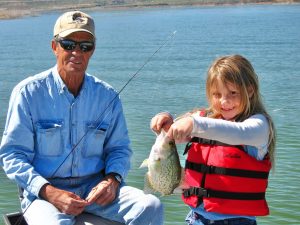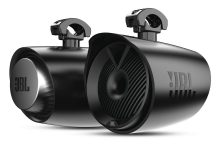
Curt Rambo is arguably the best crappie jigger in Arizona. We’ve been fishing with Curt for decades, and he knows Roosevelt like the back of his hand. While bass fishermen will tell you that staying on one spot too long is a big mistake, the opposite is true with crappie, according to Rambo. A tournament angler is on the hunt for big fish. Curt, on the other hand, just wants to have a good time and put some dinner in the livewell, since he has all but given up guiding.
His Technique
On Roosevelt, Curt fishes an occasional submerged bush, and a few brushpiles installed by dedicated crappie anglers. His technique is to sit directly over the fish and vertical jig for them. Curt drops the lure to the bottom, then tightens the line and gives the reel four or five cranks. He raises and lowers the rod slowly, watching the line for signs of a bite.
If he doesn’t get bit right away, Curt will raise the lure a little and keep on trying. He’ll stay half an hour in a spot he knows holds fish, even if he’s not getting bit. He knows he just needs to figure them out.“You should stay right there and try to figure out why the fish are there,” Curt says. He says trollers should go back over spots where they hooked up, too. Also, if you’re fishing down the bank and get a bite or two, he says you should stay there at least half an hour and try to catch more.
It’s The Depth
Besides moving too quickly, Rambo says that using the wrong jig and line can be a big mistake. “The weight of the bait and the line controls the depth and speed of the lure,” he explains, “especially if you’re trolling. The difference between a 1/32-, a 1/16-, and a 1/8-ounce jig may be only two or three feet, but it makes a big difference.”Those two or three feet can be crucial to a vertical jig presentation, he adds. When you’re jigging for crappie and not getting bit, it’s not the bait, it’s the depth. “You need to be right there.”
Curt fishes small plastics, including two-inch Berkley Power Grubs in chartreuse or white, and small Creme Lures Lit’l Fishies. He’ll rig a bunch up before a trip, using a drop of Super Glue to attach the lures to the jig heads. He spools up with braided line. The 6-pound braid has the diameter of 2-pound mono, and is strong enough to straighten out the hooks so you can retrieve your snagged jigs instead of breaking them off.
Searching For Crappie
When searching for crappie, Rambo begins by looking for a tree or some brush in 17 to 22 feet of water. At Roosevelt, this is the level that most of the crappie use most of the year, he says. He’ll fish a good tree or brushpile even if he doesn’t actually see fish around it, because sometimes they hold so tight that they don’t show up on the LCR.
“I throw a buoy out near the spot,” he explains, “then back off and cast past the buoy, letting the lure fall to just above where I think the fish are before I start retrieving it. Crappie feed up and out, so it’s better to keep the lure above them. When the bite slows down, I move right over the tree or bush and work the lure vertically.”
Detecting A Bite
Detecting a bite takes a bit of practice, because most of the time the crappie are not tugging — they just come up under the lure and suck it in. Watching your line is crucial. A twitch or sudden slack in the line may be all you get to signal a bite.
To vertical jig deeper crappie, start by dropping the jig right down to the bottom. Put the rod tip on the surface and crank your line taut so the jig is still on the bottom and your rod tip is still on the surface. Now crank the reel handle once around, lift your rod until it’s horizontal, then start jigging by slowly raising the rod tip up a foot or two and lowering it back to the horizontal position.
Nine Times Out Of Ten
Nine times out of ten the fish will bite when the lure is falling, but if they are up four feet or more off the bottom, sometimes they want to hit the lure as you lift it past them. When the fishing is really tough, the key to getting bit is just keeping the lure a few feet off the bottom and moving the boat around slowly without moving the rod at all.
When the crappie are deeper, Curt says you just have to search around for brush and try everything you find. There may be only one or two good crappie bushes on an entire flat, but once you find them, you can alternate between them all day and catch fish. If the bite turns off on one bush, go to the other one. By the time the fish turn off there, the first bush should be good again.































